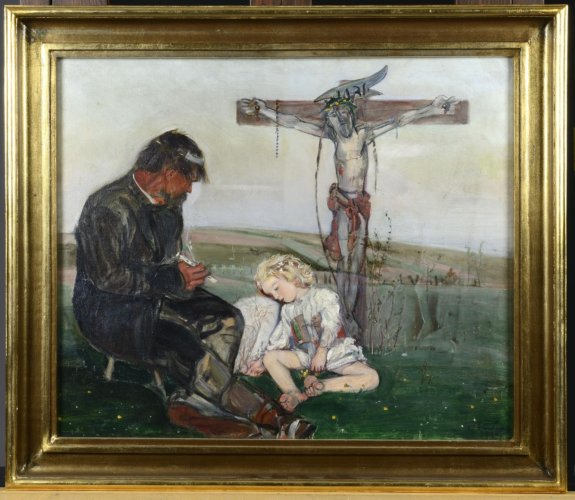Description:
Wlastimil Hofman (1881-1970) was born in Karlin, a suburb of Prague, Czech Republic, to a Czech father and a Polish mother. After moving to Krakow in 1889, his parents opened a shop with ornamental stones in the Cloth Hall. From 1895, Hofman attended evening drawing courses at the School of Fine Arts in Florian Cynk’s studio. The following year he left high school and, at the age of 16, was admitted to the Krakow School of Fine Arts. At the third year of his studies he moved to Jacek Malczewski’s studio and participated in outdoor classes with Jan Stanisławski. He graduated from the school with the opinion: „Hofman is an exceptionally talented person, he develops quickly and independently”.* That same year he went to study in Paris, where for a year he was a student of Leon Gérôme at the École des Beaux Arts. Due to financial difficulties, he was forced to return to Krakow. There, on Dębniki, he opened his first studio. In 1905 he founded the Group of Four with Mieczysław Jakimowicz, Leopold Gottlieb and Witold Wojtkiewicz, later transformed into the Group of Five (without Wojtkiewicz, with Jan Rembowski and Tymon Niesiołowski). They sought to revive the romantic idea of “correspondence of arts”, to revive the concept proclaimed by Baudelaire of the affinity of fine arts, literature and music. They appointed the great Polish romantic, poet, painter and draftsman Cyprian Kamil Norwid as their patron. Hofman participated in all the exhibitions of the group, including in Vienna (1906, 1908) and Berlin (1907). After the outbreak of World War I he left with his father to Czechoslovakia. In the summer of 1917 he returned to Poland. After the critical reviews of his first post-war exhibition, he decided to go to Szklarska Poręba. He remained there until his death – the painter died in 1970, exactly two years after his beloved wife Adela Hammerowa.
Description of the painting:
The painting “Hope” depicts the figure of a sleeping child, a man watching over him, and Jesus Crucified in the background. Sleep has been interpreted as an allegory of death since ancient times. However, it was inevitably associated with the undying hope of awakening, resurrection. In this context, a clear parallel appears between the sleeping boy and the dying Christ, the Redeemer of human sins. The child feels safe at the foot of the cross. The white stone on which the boy laid his head is the sign of happiness announced in the Holy Scripture, the resurrection from the dead, the beginning of eternal life
At first glance, a seemingly random group of characters captured by the painter on a spring meadow: a man, a child and Christ on the cross. But, as in the case of symbolic works of Jacek Malczewski, in the work of Wlastimil Hofman every, even the smallest detail has its own place and meaning. In the foreground appears a man dressed in black, in his right hand holds a pipe, on which he had just played. He turns to the little boy with concern. The child is dressed in a white shirt and a Krakow belt slipping off. He has bare feet. In his left hand he holds a bouquet of recently picked yellow cinquefoils. The boy’s head was adorned with a wreath of field bells. The child sleeps. Soothed by the music that no longer resounds, he bowed his head on the stone and fell asleep. The figure of Jesus Crucified watches over him. On the beam of the cross, on the right hand of Jesus is a string of beads resembling a rosary. The crown of thorns was decorated with cinquefoils. The scene is completed by the melancholic, subdued landscape of the lowlands spreading behind the figures.
In the Book of Revelation by Saint John we read that the Victorious one will receive from God a white stone with its new name written on it. Thus it becomes a symbol of the admission of the chosen ones to the Kingdom of God. White bells woven into a wreath adorning the boy’s forehead confirm his purity, innocence, sinlessness, constancy in faith, and beauty of soul. They are one of the plants carried on the Day of the Virgin of the Herbs to churches. They protect the household. The bouquet of mignonettes held in the closed hand of the boy in turn refers to the biblical Passover. The yellow flowers often found in meadows were one of the so-called bitter herbs which the Israelites were to eat during the holiday. They therefore foretell the offering and directly refer to the events of the Last Supper. It is not by chance that the painter has woven them into the crown of thorns.
The characteristic clothing of the figures of the painter in folk costumes, the decoration of the cross, transfers the narrative of the whole presentation from the inaccessible to the majority sphere of the sacrum, the sphere of holiness to the profane. Everyday life, meadows, flowers, a melody played on a simple flute, a rosary become an expression of deeply rooted, sincere religiosity. Decorating Christ’s forehead with yellow mignonettes does not deprive Him of holiness, but makes it more understandable, accessible, closer and truly recognized. This is also confirmed by the words of the poem-prayer written by him:
“I know nothing more, only that I love you
Christ, above all the Saints,
The most noble, and when I paint you,
I belong to those already here in heaven
Simple spirits who feel your suffering
Here beyond measure.
So accept my adoration
And further strengthen my faith
That you stand with me day and night
And you know everything that happens in the soul.
Be merciful when I call for help,
Understanding when I ask too much.
Look at the child who is not yet wise enough
When I follow in your footsteps in my own way.”*


